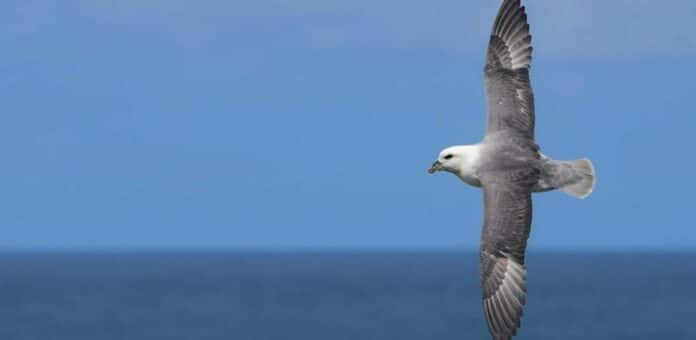A new study analyzing global tracking data for 77 species of petrel, a group of migratory seabirds, has revealed that a quarter of all plastics potentially encountered in their search for food are in remote international waters.
A group of widely dispersed migratory seabirds called petrels, which includes the Northern Fulmar, European Storm-petrel, and the Critically Endangered Newell’s Shearwater, underwent a thorough analysis of their movements. There were 7,137 individual birds from 77 different petrel species evaluated.
This is the first time tracking data from so many seabird species has been merged and superimposed on global maps of plastic distribution in the oceans.
Seabirds frequently mistake minute plastic particles for food or consume plastic their prey already consumed, resulting in damage, poisoning, and famine. Petrels are especially vulnerable since they cannot vomit the plastic readily. During the breeding season, they frequently accidentally give plastic to their young. Toxic compounds found in plastics can be detrimental to seabirds.
Petrels are a vulnerable but understudied group of marine species that play an important role in oceanic food webs. Because of the breadth of their distribution across the ocean, they are considered “sentinel species” for analyzing the risks of plastic pollution in the marine ecosystem.
Lizzie Pearmain, a Ph.D. student at the University of Cambridge’s Department of Zoology and the British Antarctic Survey and corresponding joint author of the study, said, “Ocean currents cause big swirling collections of plastic rubbish to accumulate far from land, way out of sight and beyond the jurisdiction of any one country. We found that many species of petrel spend considerable amounts of time feeding around these mid-ocean gyres, which puts them at high risk of ingesting plastic debris.”
She added, “When petrels eat plastic, it can get stuck in their stomachs and be fed to their chicks. This leaves less space for food and can cause internal injuries or release toxins.”
Climate change, bycatch, competition with fisheries, and invasive species such as mice and rats on breeding colonies are already threatening the extinction of petrels and other species.
According to the researchers, plastic exposure may impair the birds’ susceptibility to these other hazards. The Mediterranean and Black Seas account for more than half of the global plastic exposure risk for petrels. Many vulnerable seabird species forage in mid-ocean gyres of plastic trash in the northeast Pacific, South Atlantic, and southwest Indian oceans.
Dr. Bethany Clark, Seabird Science Officer at BirdLife International and corresponding joint author of the study, said, “Even species with low exposure risk have been found to eat plastic. This shows that plastic levels in the ocean are a problem for seabirds worldwide, even outside of these high exposure areas.”
She added, “Many petrel species risk exposure to plastic in the waters of several countries and the high seas during their migrations. Due to ocean currents, this plastic debris often ends up far away from its source. This highlights the need for international cooperation to tackle plastic pollution in the world’s oceans.”
The new study also discovered that the Mediterranean and Black Seas account for more than half of petrels’ global plastic exposure risk. Only four species of petrel forage in these congested, enclosed regions.
The project was led by a collaboration of the University of Cambridge, BirdLife International, the British Antarctic Survey, Fauna & Flora International, the 5 Gyres Institute, and over 200 seabird researchers from 27 nations. The findings were published in the journal Nature Communications today.
An “exposure risk score” was assigned to each species to show how likely it would come into contact with plastic while at sea. The critically endangered Balearic Shearwater, the Newell’s Shearwater, the Hawaiian Petrel, and three species listed by the IUCN as vulnerable, the Yelkouan Shearwater, the Cook’s Petrel, and the Spectacled Petrel scored highly.
Many petrels and other marine species are already in a hazardous state, even if the impacts of plastic exposure at the population level are still unknown for most species. The pressures increase with continued exposure to potentially hazardous plastics, and the findings will inform conservation efforts to try to alleviate the hazards to seabirds.
This study is a big leap forward in understanding the situation, and their results will feed into conservation work to try and address the threats to birds at sea.
The results show that plastic pollution endangers marine life globally: a quarter of all plastic exposure risk occurs in the high seas. This is due primarily to gyres, which are enormous systems of rotating ocean currents fed by rubbish entering the sea from boats and various countries.
The research was funded by the Cambridge Conservation Initiative’s Collaborative Fund for Conservation.
Journal Reference:
- Clark, B.L., Carneiro, A.P.B., Pearmain, E.J. et al. Global assessment of marine plastic exposure risk for oceanic birds. Nature Communications. DOI: 10.1038/s41467-023-38900-z
